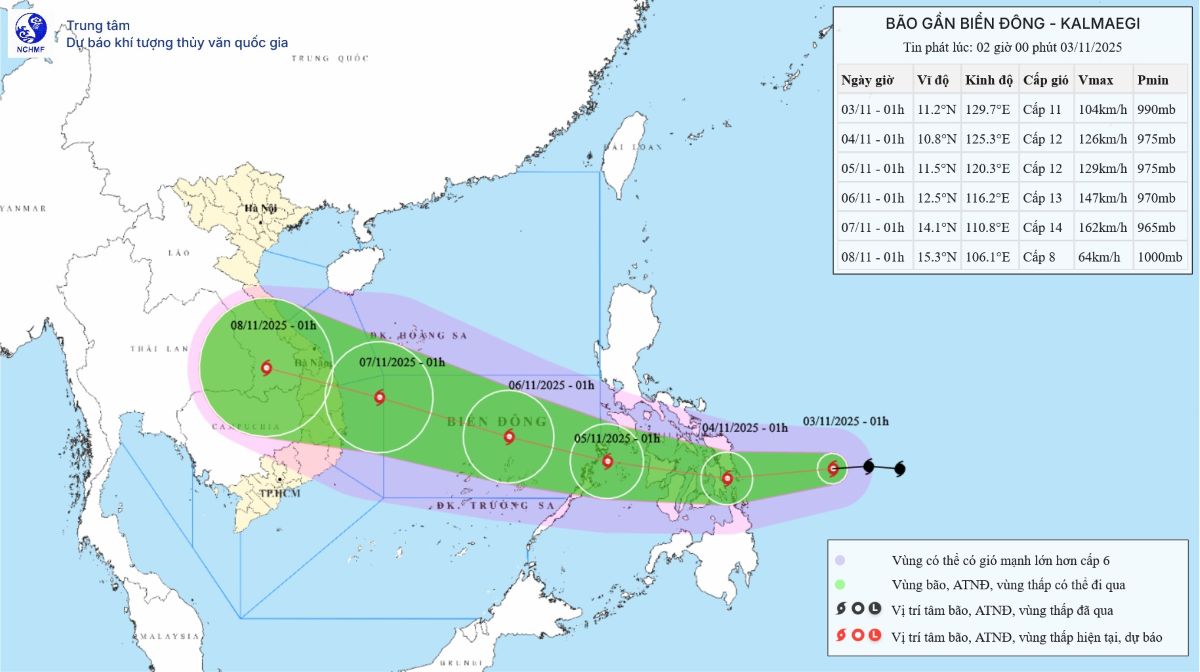The latest storm information from the Philippine Atmospheric, Geophysical and Astronomical Services Administration (PAGASA) said that at 4:00 a.m. on November 3, the center of typhoon Kalmaegi (local name: Tino) was about 430 km east of Guiuan, Eastern Samar province, moving west-southwest at a speed of 30 km/h.
The strongest wind near the center of the storm reached 110 km/h, gusting to 135 km/h; central pressure 980 hPa. The storm-force wind radius will expand to 300km.
It is forecasted that in the next 12 hours, storm Kalmaegi will continue to strengthen and may reach strong storm or super typhoon level, with expected winds of 150-165 km/h, and may even reach 185 km/h if the rapid intensification process is complete.
The conditions at sea in the Philippines are currently very favorable: High sea surface temperatures and weak wind shear - two ideal factors for storms to "increase".
If it does not change direction, Typhoon Kalmaegi is expected to make landfall in Eastern Samar, Leyte or Dinagat Island at midnight on November 3 or early tomorrow morning (November 4), then sweep across the Visayas and north of Palawan, then out into the East Sea on November 5, becoming Typhoon No. 13.
The coastal areas of Eastern Visayas, Bicol and northern Mindanao will experience heavy to very heavy rains, with the risk of flash floods and landslides in mountainous areas.
Strong winds will also spread across the central Philippines, affecting southern Luzon.
Sea level rise from 5 to 9 meters along the east coasts of Samar, Leyte and Siargao Island, endangering all types of vessels.
PAGASA warns that all sea travel activities are extremely risky, especially for small boats and fishing boats. Ship at sea need to quickly find a safe shelter.
The US Joint Typhoon Warning Center (JTWC) also confirmed that Typhoon Kalmaegi is "entering a rapid intensification phase", as the convective cloud structure around the center begins to close, forming a clear eye of the storm on satellite imagery. This means that the storm is reaching high stability and the wind will increase rapidly in the next few hours.
The Philippine Meteorological Department stressed that although Kalmaegi may weaken slightly when it makes landfall, the storm will remain strong throughout its journey through the country, before entering the East Sea.
The storm forecast bulletin at 2:00 a.m. on November 3 of the Vietnam National Center for Hydro-Meteorological Forecasting said that due to the influence of storm Kalmaegi, from around the afternoon of November 4, the sea area east of the central East Sea will have winds gradually increasing to level 6-7, then increasing to level 8-9; the area near the storm center will be strong at level 10-12, gusts of level 14-15, waves 5.0-7.0m high. The sea is rough.

Warning: Around November 5-6, the central East Sea area (including Truong Sa special zone), the sea area off the coast of Da Nang - Khanh Hoa area is likely to be affected by strong winds of level 12-14, gusting above level 17, waves 8.0-10.0m high. The sea is rough.
All ships and works operating in the above-mentioned danger zone were greatly affected by thunderstorms, whirlwinds, strong winds, and large waves.











